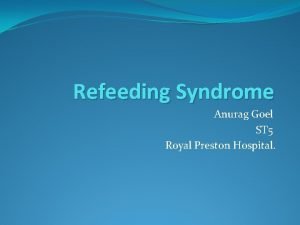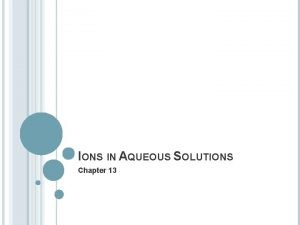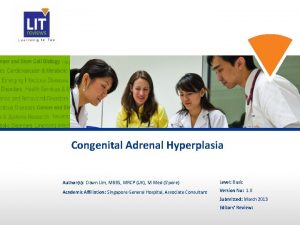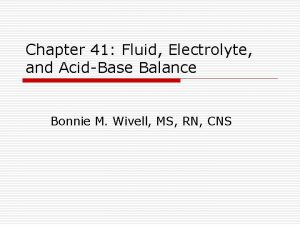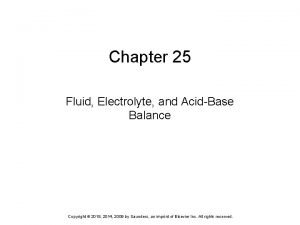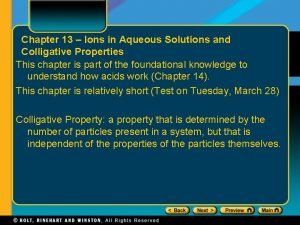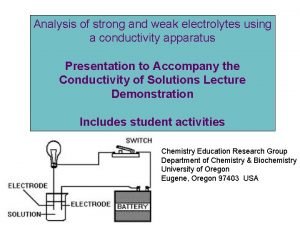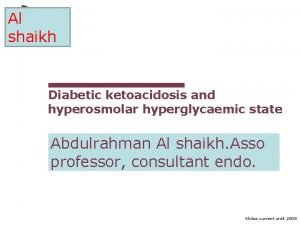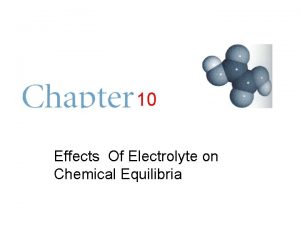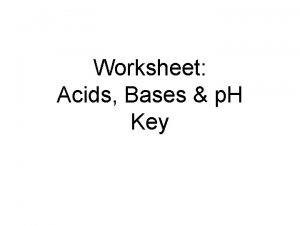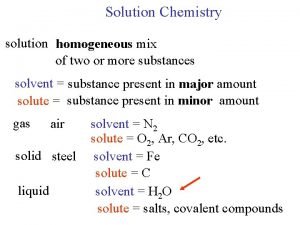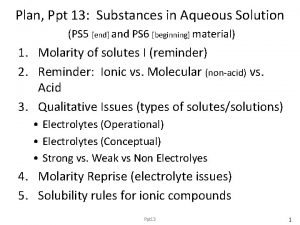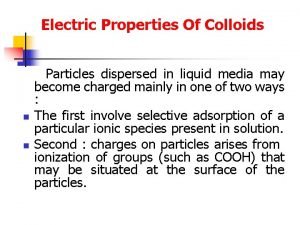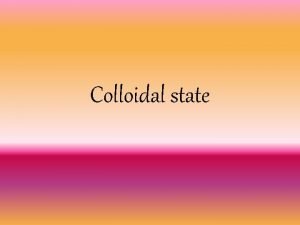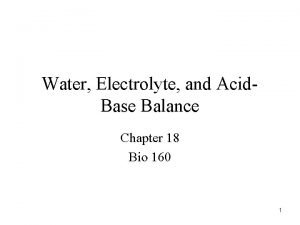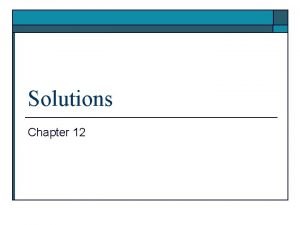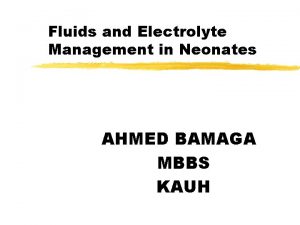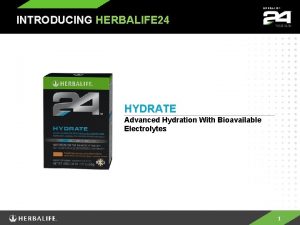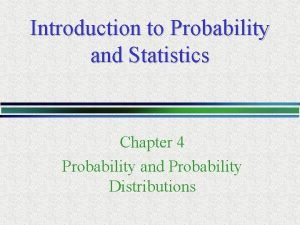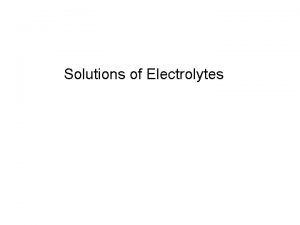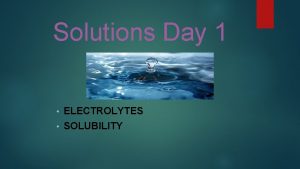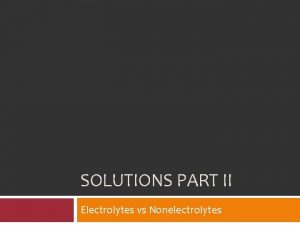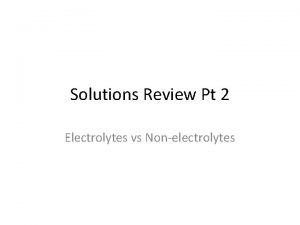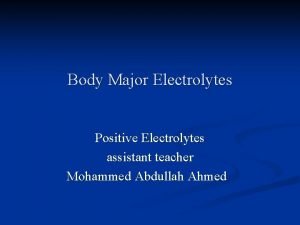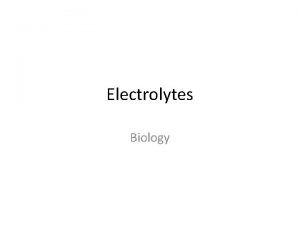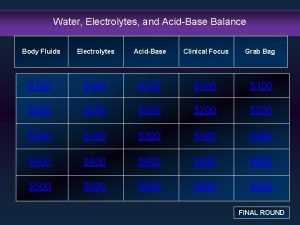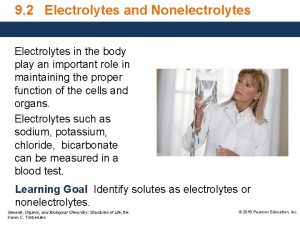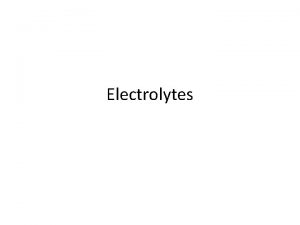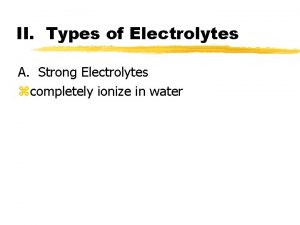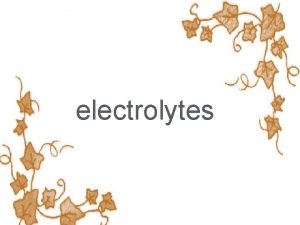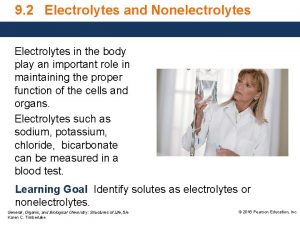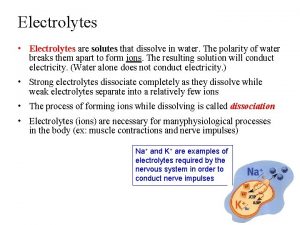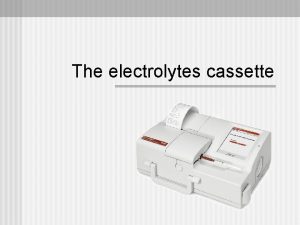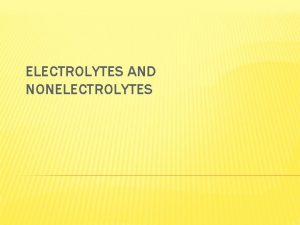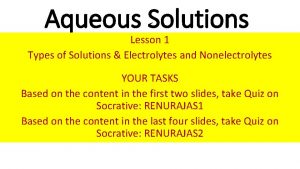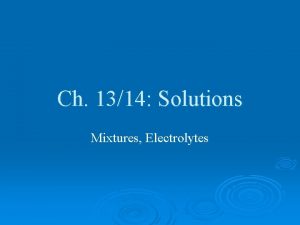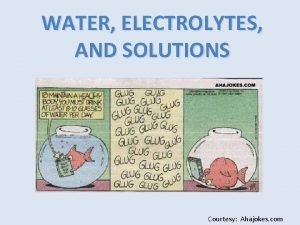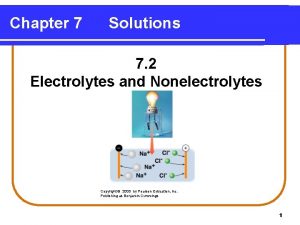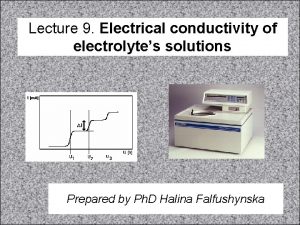Solutions of Electrolytes Introduction n n Electrolytes are




























- Slides: 28

Solutions of Electrolytes

Introduction n n Electrolytes are substances that form ions in solutions, conduct the electric current. Electrolytes may be subdivided further into strong electroytes (hydrochloric acid, sodium sulphate) and weak electrolytes (ephedrine, phenobarbital). Strong electrolytes are substances that are completely ionized when they are dissolved in water. They conduct electrical currents very efficiently. The classes of strong electrolytes include: (a) soluble salts e. g. Ba. Cl 2, (b) strong acids e. g. HCl, HNO 3, H 2 SO 4, (c) strong bases e. g. Na. OH, KOH Weak electrolytes are substances that exhibit a small degree of ionization in water. That is, they produce relatively few ions when dissolved in water. Their solutions produce a small current. The most common weak electrolytes are weak acids (e. g. acetic acid) and weak bases (ammonium hydroxide – NH 4 OH).

Properties of electrolyte solutions n Electrolysis: When a direct electric current flows through an electrolytic cell, a chemical reaction occurs. This process is known as electrolysis. n Electrons enter the cell from the battery or generator at the cathode, they combine with positive ions or cations, in the solution, and the cations are accordingly reduced. n The negative ions, or anions, carry electrons through the solution and discharge them at the anode, and the anions are accordingly oxidized. n Reduction is the addition of electrons to a chemical species, and oxidation is removal of electrons from a species.

Properties of electrolyte solutions Electrolysis in an electrolytic cell

Electrolytic conductance n n The conductance, C, is the reciprocal of the resistance, and therefore a measure of the ease with which current can pass through the conductor (or a solution). Expressed as ohms-1 or mhos The specific conductance (к ) is the conductance of a solution confined in a cube 1 cm on an edge as seen in the next slide


Electrolytic conductance n n n Specific conductance (к ) is a function of concentration. To study the dissociation of molecules into ions, independent of the concentration of the electrolyte, it is convenient to use the equivalent conductance rather than the specific conductance. All solutes of equal normality produce the same number of ions when completely dissociated, and equivalent conductance measures the current-carrying capacity of these given number of ions. Specific conductance, on the other hand, measures the currentcarrying capacity of all ions in a unit volume of solution and accordingly varies with concentration. Equivalent conductance Λ is defined as the conductance of a solution of sufficient volume to contain 1 gram equivalent of solute when measured in a cell in which the electrodes are spaced 1 cm apart. Expressed as mho. cm 2/Eq

Electrolytic conductance n n If the solution is 0. 1 N in concentration, then the volume containing 1 gram equivalent of the solute will be 10 liters (10, 000 cm 3) and the equivalent conductance will be 10, 000 times more than the specific conductance. The specific conductance of a strong electrolytic solution (к) steadily decreases on dilution, while the equivalent conductance Λ of a strong electrolyte solution steadily increases on dilution (why? ).

Electrolytic conductance n Kohlrausch studied the effect of dilution on Λ of both strong and weak electrolytes and found a discrepancy in their behavior as follows: ¡ In strong electrolytes such as Na. Cl, Λ increases linearly with decreasing square root of concentration. Extrapolation of a plot of Λ versus c to c=0 yields a value of Λ , the equivalent conductance at infinite dilution; Λ is the intercept on the vertical axis of Λ versus c plot. ¡ A quite different behavior is observed with weak electrolytes such as acetic acid. A considerable increase in Λ is noted at low concentrations, which prevents an accurate estimate of Λ. The steeply rising curve for acetic acid results from the fact that the dissociation of weak electrolytes increases on dilution, with a large increase in the number of ions capable of carrying the current.

Electrolytic conductance Equivalent conductance of strong and weak electrolytes

Electrolytic conductance n Kohlrausch concluded that ions of all electrolytes begin to migrate independently as the solution is diluted; the ions in dilute solutions are so far apart that they do not interact in any way. Under these circumstances, Λ is the sum of the equivalent conductance of the cations lcº and the anions laº at infinite dilution. Λ = lcº + laº e. g. Λ CH 3 COOH = lcºH+ + laºCH 3 COOn Based on this law, the known Λ values for certain electrolytes can be added and subtracted to yield Λ for the desired weak electrolyte.

Colligative Properties of Electrolytic Solutions and Concentrated Solutions of Nonelectrolytes n Van’t Hoff observed that the osmotic pressure of dilute solutions of nonelectrolytes could be expressed satisfactorily by the equation = RTc, in which R is the gas constant and T is the absolute temperature, and c is the concentration in moles per liter. n Van’t Hoff found, however, that solutions of electrolytes gave osmotic pressure approximately two, three, and more times larger than expected from this equation, depending on the electrolyte investigated.

Colligative Properties of Electrolytic Solutions and Concentrated Solutions of Nonelectrolytes n Van’t Hoff introduced a correction factor i to account for the irrational behavior of ionic solutions. = i. RTc n i approached the number of ions into which the molecule dissociated as the solution was made increasingly dilute. n The van’t Hoff factor i accounts for the deviations of real solutions of nonelectrolytes and electrolytes regardless of the reason for the discrepancies.

Colligative Properties of Electrolytic Solutions and Concentrated Solutions of Nonelectrolytes n The i factor is plotted against the molal concentration of both electrolytes and nonelectrolytes in the following figure. n For nonelectrolytes, i is seen to approach unity, and for strong electrolytes, it tends towards a value equal to the number of ions formed upon dissociation e. g. i approaches the value of 2 for solutes such as Na. Cl and Ca. SO 4, 3 for K 2 SO 4 and Ca. Cl 2, and 4 for Fe. Cl 3.

Colligative Properties of Electrolytic Solutions and Concentrated Solutions of Nonelectrolytes Van’t Hoff i factor of representative compounds

Colligative Properties of Electrolytic Solutions and Concentrated Solutions of Nonelectrolytes n The van’t Hoff factor can also be expressed as the ratio of any colligative property of a real solution to that of an ideal solution, since i represents the number of times greater that the colligative effect is for a real solution (electrolyte or nonelectrolyte) than for an ideal solution. p=0. 018 ip 1ºm Tf = i. Kfm = i. RTm Tb = i. Kbm

Colligative Properties of Electrolytic Solutions and Concentrated Solutions of Nonelectrolytes Example: What’s the osmotic pressure of a 2. 0 m solution of sodium chloride at 20°C? Answer: the i factor for a 2 m solution of sodium chloride as observed in the figure (slide 20) is about 1. 9 = i. RTm = 1. 9*0. 082*293*2= 91. 3 atm

Colligative Properties of Electrolytic Solutions and Concentrated Solutions of Nonelectrolytes n Solve problem 6 -5 page 141 from Martin’s Physical Pharmacy book – fourth edition. n If you have the fifth edition of Martin’s Physical Pharmacy book, solve problem 6 -5 page 696.

Arrhenius Theory of Electrolytic Dissociation n Arrhenius proposed the now classic theory of dissociation: when electrolytes are dissolved in solution, the solute exists in the form of ions in the solution. Na. Cl + H 2 O → Na+ + Cl- + H 2 O HCl + H 2 O → H 3 O+ + Cl. CH 3 COOH + H 2 O CH 3 COO- + H 3 O+ n In fact, Arrhenius did not consider strong electrolytes to be ionized completely except in extremely diluted solutions. He differentiated between strong and weak electrolytes by the fraction of the molecules ionized: the degree of dissociation . n A strong electrolytes is one that dissociated into ions to a high degree and a weak electrolyte is one that dissociated into ions to a low degree.

Arrhenius Theory of Electrolytic Dissociation n Two methods can be used to determine the degree of dissociation: n First method: the degree of dissociation can be determined from conductance measurements. Equivalent conductance at infinite dilution Λ was a measure of the complete dissociation of the solute into its ions and that Λc represented the number of solute particles present as ions at concentration c. n Hence the fraction of solute molecules ionized, or the degree of dissociation, can be expressed by the equation in which Λc/ Λ is known as the conductance ratio

Arrhenius Theory of Electrolytic Dissociation Example: The equivalent conductance of acetic acid at 25°C and at infinite dilution is 390. 7 mho cm 2/Eq. The equivalent conductance of a 5. 9*10 -3 M solution of acetic acid is 14. 4 mho cm 2/Eq. What’s the degree of dissociation of acetic acid at this concentration? Answer: = 14. 4/390. 7 = 0. 037 or 3. 7%

Arrhenius Theory of Electrolytic Dissociation n Second method to find : The van’t Hoff factor i can be connected with the degree of dissociation in the following way: where v is the number of ions produced from the electrolyte ionization e. g. for Na. Cl v=2, for Ca. Cl 2 v=3 n The cryoscopic method is used to determine i from the expression

Arrhenius Theory of Electrolytic Dissociation Example: Calculate the degree of ionization of 0. 1 m acetic acid providing that its freezing point is -0. 188°C. Answer: Acetic acid dissociates into two ions, so v = 2. To calculate i: = 0. 188/ (1. 86*0. 1)= 1. 011 It is possible now to calculate the degree of ionization: = (1. 011 -1)/ (2 -1) = 0. 011 or 1. 1%

Arrhenius Theory of Electrolytic Dissociation n The Arrhenius theory is now accepted for describing the behavior only of weak electrolytes. The degree of dissociation of a weak electrolyte can be calculated satisfactorily from the conductance ratio or obtained from the van’t Hoff factor i. n As for strong electrolytes, they dissociate completely in dilute and moderately concentrated solution. n Moreover, a discrepancy exists between calculated from i ratio and calculated from the conductivity ratio for strong electrolyte solutions at concentrations greater than about 0. 5 M. n Thus degree of dissociation according to Arrhenius theory does not account for behavior of strong electrolyte. Instead, it is more convenient to consider a strong electrolyte as completely ionized and to introduce a factor that expresses the deviation of the solute from 100% ionization. The activity and activity coefficient are used for this purpose.

Arrhenius Theory of Electrolytic Dissociation n Solve example 6 -7 page 131, example 6 -8 page 131 and problems 6 -8, 6 -9, and 6 -10 page 141 from Martin’s physical pharmacy book. n If you have fifth edition of Martin’s physical pharmacy book, solve example 6 -7 page 150, example 6 -8 page 150 and problems 6 -8, 6 -9, and 6 -10 page 696.

Activity and Activity Coefficient n The large number of oppositely charged ions in solutions of strong electrolytes influence one another through interionic attractive forces. n For solution of nonelectrolytes, regardless of concentration, the number of ions is small and the interionic attractive forces are insignificant. n As for strong electrolytes, ions can associate at high concentrations into groups known as ion pairs. Thus the values of the freezing point depression and the other colligative properties are less than expected for solutions of unhindered ions. Consequently, a strong electrolyte may be completely ionized, yet incompletely dissociated into free ions. n You may think of the solution as having an “effective concentration” or, as it is called, an activity. This concept was first introduced by Lewis and Randall.

Activity and Activity Coefficient n The activity (a), in general, is less than the actual or stoichiometric concentration of the solute (m), not because the strong electrolytes are partly ionized, but rather because some of the ions are effectively “taken out of play” by the electrostatic forces of interaction. n At infinite dilution in which the ions are so widely separated that they do not interact with one another, the activity a of an ion is equal to its concentration: a = m. n As the concentration of the solution is increased, the ratio becomes less than unity because the effective concentration or activity of ions becomes less than the molal concentration. This ratio is known as the practical activity coefficient ( ), thus: a = m

Activity and Activity Coefficient n A cation and an anion in an aqueous solution may each have a different ionic activity. n The activity of an electrolyte is defined by its mean ionic activity a a = (a+ma-n)1/(m+n) n where a+ is the activity of the cation, and a- is the activity of the anion, the exponents m and n give the stoichiometric number of given ions that are in solution. n Thus an Na. Cl solution has a mean ionic activity of a = (a. Na+a. Cl-)1/2 n Whereas an Fe. Cl 3 solution has a mean ionic activity of a = (a. Fe+3 a. Cl-3)1/4
 Mikael ferm
Mikael ferm Weak electrolytes examples
Weak electrolytes examples рефидинг синдром
рефидинг синдром Medicare enteral qualification checklist
Medicare enteral qualification checklist Strong vs weak electrolytes
Strong vs weak electrolytes Congenital adrenal hyperplasia electrolytes
Congenital adrenal hyperplasia electrolytes Rome mnemonic for acid base balance
Rome mnemonic for acid base balance Chapter 25 fluid electrolyte and acid-base balance
Chapter 25 fluid electrolyte and acid-base balance Strong vs weak electrolytes
Strong vs weak electrolytes Is sucrose soluble in water
Is sucrose soluble in water Diabetic ketoacidosis
Diabetic ketoacidosis How does electrolytes affect the chemical equilibria?
How does electrolytes affect the chemical equilibria? Vacid definition
Vacid definition Weak electrolytes
Weak electrolytes Tropolar
Tropolar Effect of electrolytes on colloidal dispersion
Effect of electrolytes on colloidal dispersion Protective colloids definition
Protective colloids definition Chapter 18 fluids and electrolytes
Chapter 18 fluids and electrolytes Vapor pressure lowering
Vapor pressure lowering Major intra and extracellular electrolytes
Major intra and extracellular electrolytes Electrolytes and nonelectrolytes
Electrolytes and nonelectrolytes Herbalife hydrate 24
Herbalife hydrate 24 Introduction to management science solution
Introduction to management science solution Introduction to management science chapter 1 solutions
Introduction to management science chapter 1 solutions Probability of a and b
Probability of a and b Introduction to software testing exercises solutions
Introduction to software testing exercises solutions Essay structure introduction
Essay structure introduction Classroom lockdown device
Classroom lockdown device Survey solutions designer
Survey solutions designer


